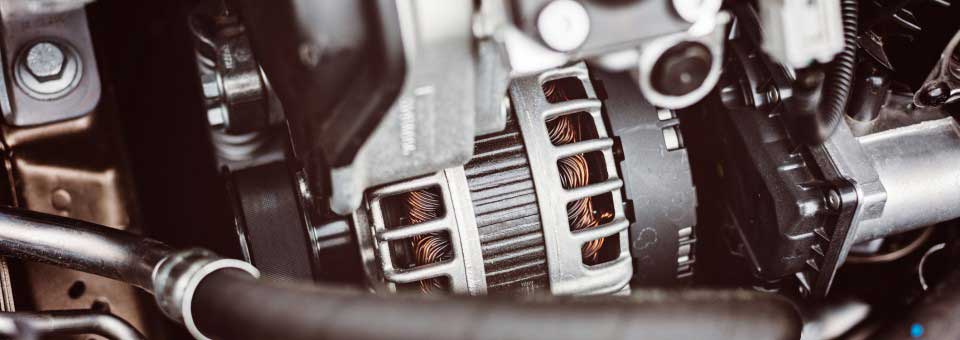Your alternator plays a critical role by keeping your car’s battery charged, but can also be notorious as the top reason car batteries die. On average, a car’s alternator lasts about seven years or around 150,000 miles. But how does an alternator work and what are some signs that it may be malfunctioning?
How does the alternator work?
In essence, a car’s alternator is used to charge the battery and support your vehicle’s electrical system while it’s out on the road.
Fun fact: the car alternator got its name from the phrase “alternating current” or AC.
The alternator turns mechanical energy into electrical energy which gets directed to the battery and goes on to power all your car’s electrical systems. Even though the car’s battery gets all the credit for powering electrical systems, the truth is that the alternator provides the energy while the vehicle is running.
Alternator components
The following is a breakdown of an alternator’s main components.
Stator and rotor. The stator and rotor work together to turn mechanical energy into electricity. When your car is running a collection of magnets on the rotor spin rapidly inside the stator. The stator includes bundles of tightly wound copper wire called windings. As the magnets spin inside the copper windings an alternating current is generated.
Diodes. The diodes perform two key functions within the alternator. They transform the alternating current into direct current which is used to charge your car’s battery. The diodes also make sure that the electric current only flows in one direction, from the alternator to the car battery.
Voltage regulator. The voltage regulator works in much the same way as a surge protector. It makes certain that voltage in the charging system stays within an acceptable range.
Cooling fan. This entire process generates a lot of heat. A fan inside the alternator protects the system by helping dissipate that heat.
Signs of alternator malfunction
Warning light. Your car’s dashboard should be one of your first stops when checking for alternator malfunctions. The icon looks like a battery which, when lit, indicates that there’s an issue with the charging of the battery. If this light turns on while you’re driving, shut off unnecessary electrical components (like air conditioning and your stereo). If possible, don’t turn off the engine until you’re in a place where help is available.
Dimming lights. Another sign of the alternator going out is the dimming of your car’s headlights and dashboard. Other common signs include a reduction in energy to heated seats and windows which cause a slowdown in their function.
Grinding noises. Alternators count on various parts to keep them spinning, such as pulleys and belts. These pieces might produce grinding noises when wearing out. Whether it’s the bushings or the bearings, any odd whining or grinding could be a sign that these parts are failing.
Weird smells. If you smell some burning rubber, that frequently means that there’s a problem with the car’s alternator. This issue can happen when a misaligned component causes friction and heats up the belt.
Shopping for an alternator: What to keep in mind
Replacing an alternator requires an investment, and no one wants to be stuck with a defective alternator. There are a few things you can do to make sure you’re purchasing a good alternator:
Don’t buy it from just anyone. This is not the time to find the lowest price and buy from an unfamiliar source. Purchasing a well-known alternator brand from a respected retailer reduces the chance of getting a bad alternator.
Get a long warranty. This is another way to reduce your chances of getting stuck with a defective alternator. Different alternators have different warranty periods. Making sure you get a decent warranty may give you some peace of mind.
Bockman’s Auto, Truck & Tire, a DeKalb County NAPA AutoCare Center, currently has a special promotion for NAPA batteries, starters, and, yes, alternators. Check with us when you are having service or repair done and we’ll help guide you to the right decision.

